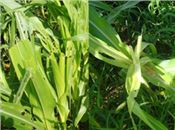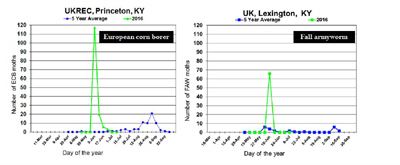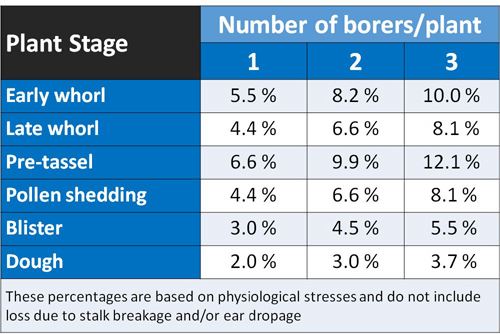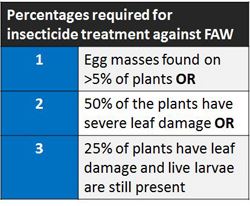|
Caterpillars May Affect Late Corn Planting In Different Areas Of Kentucky In 2016
DR. RAUL VILLANUEVA, PATRICIA LUCAS, DR. RIC BESSIN
PRINCETON, KY.
In Clinton and Todd counties, damage to corn and sweet sorghum has been reported to Drs. Lee Townsend and Ric Bessin since mid-June; and I have noticed injuries on corn foliage in Princeton during the last 2 weeks. This damage might be caused by the European corn borer (ECB), Ostrinia nubilalis, or the fall armyworm (FAW), Spodotera frugiperda. Caterpillars of these two species consume leaves during their larval development. This feeding results in plants with ragged appearance and the presence of abundant frass or feces near the whorl (Figure 1).
Larvae of these species sometimes are hard to see. It is necessary to look deep into a whorl to find a larva. Once inside the whorl, larvae are well protected, and insecticides applications won’t be effective.
Trap Counts
The presence of this damage coincides with the captures of male specimens of ECB and FAW in pheromone baited traps in Princeton and Lexington, respectively. Trap catches of ECB reached their peak by June 5 (greater than 110 ECB/trap), whereas FAW captures in Lexington peaked by June 10 (greater than 60 FAW/trap). In both cases, their numbers were much higher than the 5-year average captures for the two species at the corresponding dates (Figure 2). Data on pheromone baited traps of these two species, as well as cutworms, armyworms, Southwestern corn borer, and corn earworm/ can be found on the UK IPM webpage.
Life Cycles
ECB overwinters as larvae in Kentucky and the high numbers of male captures might be associated with the mild winter in 2016. FAW migrates every year from their overwintering states along the Gulf Coast, and its population usually reaches its peak in August and September in Kentucky during late pre-tassel. FAW has 5 generations in southern states; in Kentucky it can have 3 generations per year. Plants can recover from earlier damage; however, late damage can affect the ears and cause economic losses.
Scouting & Management
Scouting for ECB and FAW is somewhat similar. To scout for these species, consultants/growers should check 20 consecutive plants (selecting the first randomly) from at least 5 locations in the field. However, for management decisions regarding insecticides applications, the time of scouting and threshold are somewhat different.
For the first generation ECB, control should be done if 50 percent of the plants show fresh windowpane damage. Also, ECB can cause different yields losses depending on the number of borers in the plant and the plant stage (Table 1).
For FAW activity, begin checking corn by mid-June. Small FAW larvae cause “window pane” damage to leaves similar to ECB. For FAW, check plants a few days before tasseling, search deep into the whorls for large larvae. These larvae may attack young ears. Continue to check for this insect until silks begin to dry. Thresholds for FAW are presented on Table 2.
In both cases (ECB and FAW), check thoroughly for the presence of live larvae. ∆
DR. RAUL T. VILLANUEVA, Extension Entomologist; PATRICIA LUCAS, IPM Specialist and DR. RIC BESSIN, Extension Entomologist, University of Kentucky

Figure 1. Caterpillar damage on corn by European corn borer (ECB). Notice the abundant frass on the whorl from ECB
or fall armyworm caterpillars (right).
Photo: Raul Villanueva, UK

Figure 2. Numbers of male European corn borer,
and fall armyworm captured in pheromone baited traps in Princeton and Lexington, respectively in 2016 and a 5-year average.

Table 1. Percentages of yield losses caused by European corn
borers for various corn growth stages (modified from
https://extension.entm.purdue.edu/publications/E-17.pdf)

Table 2. FAW thresholds for insecticide treatment
|
|